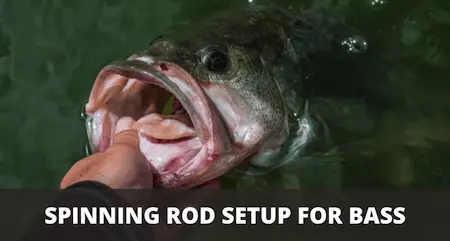What Is A Good Spinning Rod And Reel Setup For Bass Fishing?
UPDATED 17 MAY 2023
by Robert Ceran
If you’re new to bass fishing, you’re probably bewildered by all the different bass fishing rod and reel setups to choose from.
And to make matters worse, you also have to choose between three main types of fishing rods – either casting, spincast, or spinning rod setup.
To make your choice easier, we’ve put together the best spinning rod setup for bass that will have you covered in 90% of all bass fishing scenarios you’re likely to encounter.
Spinning rods setups are much easier to master than casting setups, which is why they are a great option for beginners.

They are also much better suited for lightweight & finesse applications, and even seasoned bass anglers like to use them for this reason.
We’ve split this bass fishing rod and reel setup guide into four main components:
- Spinning rod
- Spinning reel
- Fishing line
- Fishing lures/rigs
All of the components listed in this article are highly versatile, which means they can be used for great all around bass fishing rod and reel setups.
Bass fishing rod setup
- Spinning rod length: 7 foot
- Power: Medium or Medium Light
- Action: Fast
When it comes to spinning rod length for bass fishing, 7’ is perfect, as it represents an ideal compromise between a shorter pole (which enables higher casting accuracy), and a longer rod (which enables greater casting distance).
The main exception to this would be if you’re specifically looking for a topwater rod, which needs to be shorter, since you have to point the rod tip down to the water surface during lure retrieval.
In terms of rod power, Medium or Medium Light are the best options for a bass fishing pole setup.
You don’t want to choose a rod that’s too light, since you need enough backbone to set your hook in the bony mouth of a bass.
Also, if you hook into a sizable fish north of 5 pounds, you’ll want sufficient rod power to pull it away from any nearby cover.
Finally, when it comes to rod action, Fast action is the way to go, since that works well for casting lightweight lures and rigs, and is also great for precise control of lure movement during retrieval.
Ideal all around spinning reel specs for bass
- Reel size: 2500
- Retrieve speed: medium (25 to 35 inches per turn)
It’s not really a good idea to use a super light spinning reel with a bass fishing rod setup, since bass can grow to respectable sizes of over 10 pounds, and as you probably know, they put up an explosive fight after being hooked.
That’s why a 2500 spinning reel size is ideal, since it’s stronger than the ultra light 1000 or 2000 models, but it’s still light enough to work well with lightweight lures and rigs.
In terms of retrieve rate, a medium speed model with 25 to 35 inches per turn is ideal. The reason for this is that spinning rods are often used for finesse tactics, which involve moving your lure or bait more slowly, combined with more subtle movements.
Finesse techniques are easier to carry out with a medium speed reel than with a fast model. On the other hand, you don’t want your reel to be too slow, since you need to be able to crank a fish away from cover as fast as possible after hooking it.
Ideal line setup for bass fishing with a spinning rod
- Main line: 10-15 lb braided line
- Leader: 6-10 lb fluorocarbon
You can readily use any of the 3 types of fishing line (monofilament, braid, or fluorocarbon) on a spinning rod.
But we recommend using the following combination: 10 or 15 lb braided line as your main line, plus a 6 to 10 lb fluorocarbon leader.
Braided line has the advantage of having little to no stretch, which means you can feel every little tug on your lure during retrieval, which is great for detecting subtle bites.
It’s also better suited for greater casting distance, but comes with the disadvantage of being highly visible in the water. That’s why you need to tie it to a fluorocarbon leader to avoid bass spotting your line.
The fluorocarbon leader needs to be sufficiently long – at least 20’ or 25’. The reason for this is that you want your lure to sink readily in the water, which works well with fluorocarbon, but not with braid, since that tends to float on the water surface.
Ideal lures and rigs to use with a spinning setup for bass
- Micro jigs
- Small worms
- Tubes/soft plastics
- Shaky heads
- Drop shot rig
- Ned rig
- Wacky rig
- Neko rig
Spinning rods are great for throwing any small lures or finesse rigs under 1/4 oz, which is why they are ideal for lightweight fishing applications. For more detailed information on this topic, check out our article what lures are best for spinning rods?
Another advantage of using a spinning rod setup is that it is more sensitive than a casting setup, which helps to detect subtle bites.
Especially when a cold front moves in, bass become lethargic and don’t feed very actively.
This is precisely why lightweight tactics are ideal for catching them under these conditions. For the full scoop on this topic, check out this article: are spinning rods good for bass?
If you want to fish with bigger lures, such as over-sized jigs or deep diving crankbaits, it’s better to use a casting rod setup, since this works best with big lures, and not so well with smaller ones.
Conclusion
In summary, the ideal bass rod setup with a spinning rod and reel consists of a 7’ medium power/fast action rod combined with a 2500 medium speed spinning reel, spooled with a 15 lb braided main line and a 8 lb fluorocarbon leader.
This setup can be used effectively with a wide range of lures weighing less than 1/4 oz, which makes it one of the best bass fishing rod and reel setups for finesse tactics.
In case you’re looking for a rod to use for a specific bass fishing application, take a look at our in-depth review of the best bass spinning rods, where we discuss different rod models for different bass fishing tactics, such as fishing with drop shot rigs, crankbaits, or topwater lures.
